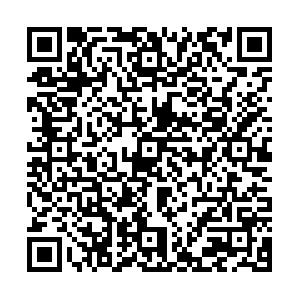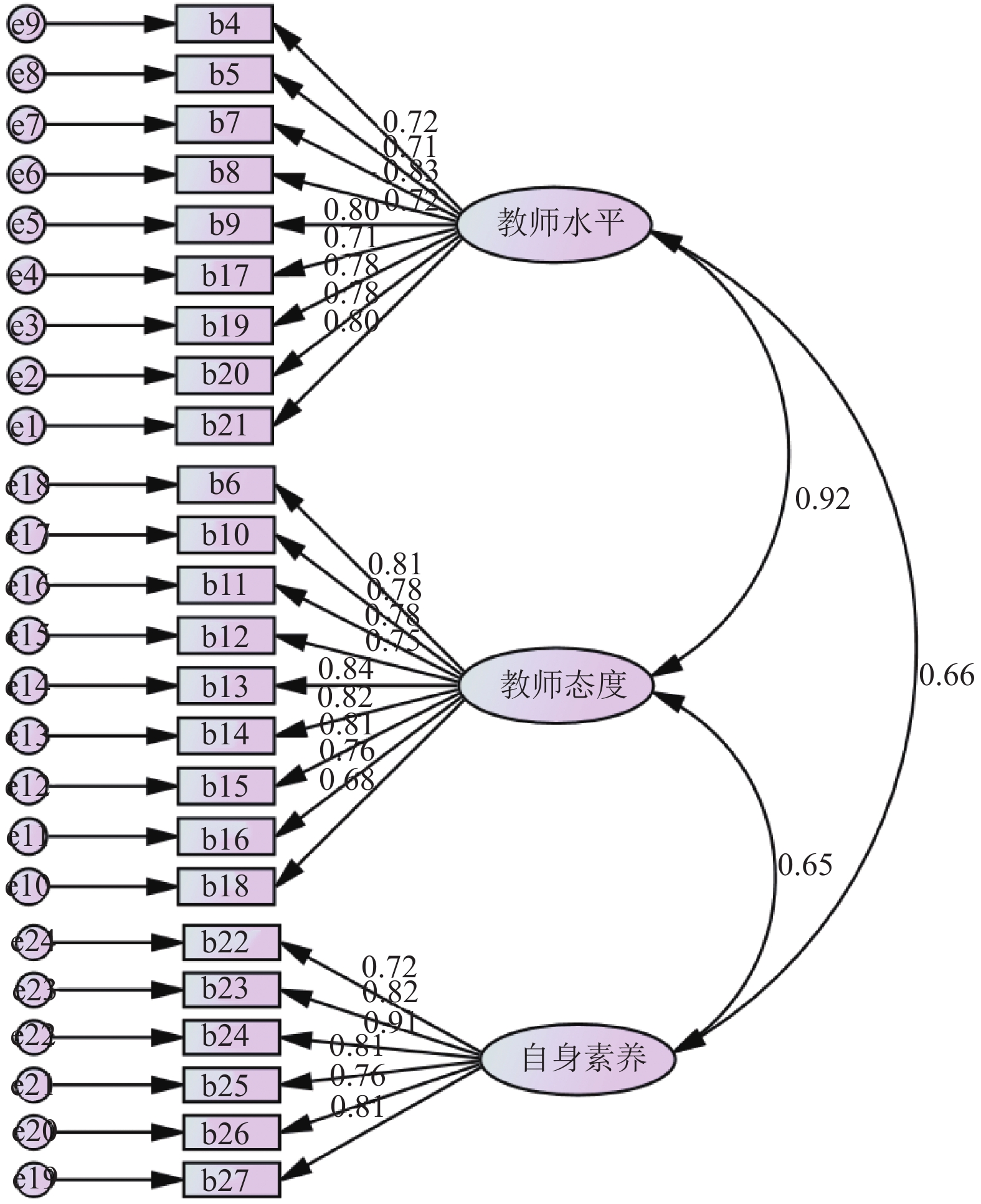Reliability and Validity of A Questionnaire for International Students in China with Educational Service Satisfaction in English Version-Taking Kunming Medical University as A Case
-
摘要:
目的 评价来华留学生全英文教学满意度量表(ISCESSE)的信度和效度。 方法 通过查阅文献、专家访谈和预调查自行编制全英文版本留学生教学服务满意度量表,对结果进行量表的信度和效度检验。其中信度用内部一致性的Cronbach’ s α系数、折半信度和组合信度、效度采用探索性因子分析和验证性因子分析评价量表的效度。 结果 共回收有效量表112份。该量表提取出教师教学水平、教师教学态度和学生自身素养3个维度,共24个条目。量表总的Cronbach’ s α系数为0.961,折半信度系数0.907,三个维度的Cronbach’ s α系数分别为0.926、0.935、0.917,组合信度为0.896、0.912、0.925。经过探索性因子分析,提取三个因子的累积方差贡献率分别是53.7%、62.9%和68.9%。各维度与总量表的相关系数为0.803~0.935 (P < 0.05)。验证性因子分析,模型整体适配度指标(如卡方自由度比值,RMSEA)基本满足要求,参数估计值误差方差均无负值,各条目与所在维度之间的标准化参数估计值除1个小于0.7外,其它均接近或高于0.8。 结论 该量表具有较好的信度和效度,可用于昆明医科大学来华留学生全英文教学服务满意度的评估。 Abstract:Objective To evaluate the reliability and validity of a questionnaire for International Students in China with Educational Service Satisfaction English version (ISCESSE). Methods Item and performance indicators were selected after expert groups discussion and preliminary experiments to construct the ISESSE. Cronbach's α coefficient and split-half reliability were used to evaluate the reliability as well as composite reliability. Exploratory factor analysis (EFA) and confirmatory factor analysis (CFA) were used to evaluate the validity. Results A total of 112 students were enrolled. The Cronbach's α coefficient, split-half reliability of the scale were 0.961, 0.907. The composite reliability of 3 dimension was 0.896、0.912、0.925, respectively. The Cronbach's αcoefficient of 3 dimension with 24 items was 0.926、0.935、0.917, respectively. EFA showed the cumulative variance proportion were 53.7%, 62.9%, and 68.9%. The correlation coefficients of each dimension and the total questionnaire ranged from 0.803 to 0.935 (P < 0.05). CFA showed that the goodness of fit index (such as χ2, RMSEA) indicated good model fitting and good structure validity. Except for one less than 0.7, the standardized parameters between each item and dimension were all close to or higher than 0.8, which also suggested a very favorable validity. Conclusion The established ISESSE is of good reliability and validity and could be used to evaluate the international students' Educational Service Satisfaction in Kunming Medical University. -
表 1 ISESSE量表信度检验结果
Table 1. Reliability test results of ISESSE
维度(子题目数目) 克隆巴赫系数 折半系数 组合信度 教师教学水平(9) 0.925 0.896 0.926 教师教学态度(9) 0.933 0.912 0.935 学生自身素养(6) 0.915 0.925 0.917 量表总体(24) 0.961 0.907 0.972 表 2 ISCESSE量表条目在医学生中的因子载荷(n = 112)
Table 2. Factor loading of ISESSE scale in medical students (n = 112)
条目 教师教学
水平教师教学
态度学生自身
素养专业知识、技能水平 0.823 内容符合学生发展 0.716 跨文化意识 0.714 内容具有条理性和丰富性 0.694 全英文教学水平 0.664 不依赖于教材或ppt 0.662 不照本宣科,联系实际 0.654 多种教学方法 0.472 态度认真、严谨、敬业 0.455 课堂上给予足够的关注 0.942 积极与同学互动交流 0.787 优化和选择教学方法 0.704 引入知识和培养能力 0.613 按时上下课 0.541 课堂气氛民主、开放 0.535 平易近人,公平对待同学 0.506 调动气氛、及时回答问题 0.498 积极充实和更新教学内容 0.438 学生自身的学习态度 0.888 学生的英语成绩 0.849 学生思考发言,参与互动 0.839 学生完成课堂任务或作业 0.776 学生出勤率 0.686 学生课堂收获 0.674 特征值 12.885 2.220 1.205 方差贡献率 0.537 0.092 0.050 累计方差贡献率 0.537 0.629 0.680 表 3 ISCESSE量表验证性因子分析模型评价结果(n = 112)
Table 3. CFA of ISCESSE scale with model evaluation (n = 112)
项目 χ2/df CFI IFI TLI PGFI PNFI PCFI RMSEA 模型 2.574 0.826 0.828 0.807 0.902 0.673 0.745 0.119 拟合度判断标准 < 3 > 0.9 > 0.9 > 0.9 > 0.5 > 0.5 > 0.5 < 0.1 表 4 ISCESSE总量表与各维度的Spearman 相关系数(rs)
Table 4. Spearman’s rank correlation coefficient (rs) of ISCESSE total scale and each dimension
项目 教师教学水平 教师教学态度 学生自身素养 量表总体 教师教学水平 1 教师教学态度 .848** 1 学生自身素养 .614** .618** 1 量表总体 .935** .934** .803** 1 注:*P < 0.05, ** P < 0.01。 -
[1] 崔延强, 李云梅. “一带一路”倡议下大学国际化发展问题研究—基于云南省中外合作办学现状的考察[J]. 教师教育学报,2019,6(1):83-91. [2] 李红宾, 梁红敏, 彭云珠, 等. 来华留学生临床教学质量提升探索与实践[J]. 昆明医科大学学报,2020,41(3):150-153. doi: 10.3969/j.issn.1003-4706.2020.03.029 [3] 隋婧, 赵心蕊, 和一之, 等. 中国西部地区医学留学生教育现状调查及对策思考[J]. 临床医学研究与实践,2019,4(6):187-191. [4] 梁乃文, 王小燕, 侯振挺, 等. 湖南省公众安全感调查问卷及其与信度和效度分析[J]. 数理统计与管理,2012,31(6):1039-1048. [5] Berglund A L, Ericsson K. Different meanings of quality of life: a comparison between what elderly persons and geriatric staff believe is of importance[J]. Int J Nurs Pract,2003,9(2):112-119. doi: 10.1046/j.1322-7114.2003.00414.x [6] Fornell C, Larcker D F. Evaluating structural equation models with unobservable variables and measurement error[J]. Journal of Marketing Research,1981,18(1):39-50. doi: 10.1177/002224378101800104 [7] 孟琼, 罗家洪, 万崇华, 等. 胃癌患者生命质量测定量表EORTC QLQ-STO22中文版的制定和评价[J]. 昆明医科大学学报,2012,33(10):34-38. doi: 10.3969/j.issn.1003-4706.2012.10.009 [8] Van Der Scheer E A, Bijlsma H J E, Glas C A W. Validity and reliability of student perceptions of teaching quality in primary education[J]. School Effectiveness and School Improvement,2019,30(1):30-50. doi: 10.1080/09243453.2018.1539015 [9] 李跃平, 黄子杰. 验证性因子分析在量表结构效度考核中作用[J]. 中国公共卫生,2007,(10):1198-1199. doi: 10.11847/zgggws2007-23-10-25 [10] 吴明隆. 结构方程模型-AMOS的操作与应用[M]. 重庆: 重庆大学出版社, 2010: 37-68. [11] 熊家豪, 牟劲松, 赵淑英, 等. 我国大学生健康素养问卷的研制及信度和效度评价[J]. 中国卫生统计,2018,35(4):518-521. [12] Bakker A B. The work-related flow inventory: Construction and initial validation of the WOLF[J]. Journal of Vocational Behavior,2008,72(3):400-414. doi: 10.1016/j.jvb.2007.11.007 [13] 中国教育国际交流协会国际医学教育分会, 《来华留学生临床医学专业本科教育(英语授课)质量控制标准(试行)》[EB/OL].(2020-05-09)[2020-12-12]. http://www.ceaie.edu.cn/shewaibanxuezhiliangbaozhangbu/tongzhigonggao/1970.html. [14] 雷雯, 吴文娟, 李振坤, 等. 参与式教学在MBBS学生见习教学中的效果评价[J]. 昆明医科大学学报,2018,39(5):138-140. [15] 黄鑫, 胡敏予, 黄忆明. 血脂知识-态度-行为问卷的信度和效度检验[J]. 卫生研究,2008,(2):204-206. [16] Aydoğan S, Atay E, Metintaş S, et al. Reliability and validity of disability literacy scale for medical school students[J]. European Journal of Public Health,2019,29(Suppl4):298. [17] Ocal E E, Onsuz M F. Reliability and validity of healthy lifestyle behaviours scale in children[J]. European Journal of Public Health,2020,30(5):392. [18] Huang A Y, Wu K S, Li A N, et al. The reliability and validity of an assessment tool for developmental dyslexia in Chinese children[J]. International Journal of Environmental Research and Public Health,2020,17(10):3660. doi: 10.3390/ijerph17103660 [19] 郭太玮, 朱勤, 施鸿飞. 基于结构方程模型的大学生亚健康量表效度测评[J]. 中国卫生统计,2013,30(1):23-26,30. [20] 赵斐然, 周天驰, 张俊颖, 等. 量表(问卷)信度、效度评价在我国医学领域的应用与展望[J]. 中华中医药杂志,2014,29(7):2280-2283. -






 下载:
下载:


